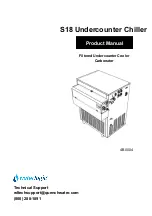
100862 - FRONT TiNE TiLLER
MAiNTENANCE
23
a. Tine inspection:
With use, the tines will become shorter, narrower and pointed.
Badly worn tines will result in a loss of tilling depth, and reduced
effectiveness when chopping up and turning under organic matter.
B. removing/installing a Single Tine:
1. With the engine shut off and the spark plug wire
disconnected, remove the M10×25 bolt, lock washer, flat
washer and M10 nut that attach a single tine to a tine holder.
If needed, use penetrating oil on the nuts.
2. When installing a single tine, be sure to position it so that its
cutting edge (sharp) will enter the soil first as the tiller moves
forward. Hand tighten completely.
C. removing/installing a Tine assembly:
1. A tine assembly consists of eight tines mounted on a tine
holder.
2. If removing both tine assemblies, mark them “left” and
“right” before removal. Remove (2) pins and (2) cotter pins
that secure the tine assembly to the tine shaft. If necessary,
use a rubber mallet to tap the tine assembly outward off the
shaft.
3. Before reinstalling the tine assembly, inspect the tine shaft
for rust, rough spots or burrs. Lightly file or sand, as needed.
Apply a thin coat of grease to the shaft.
4. Install each tine assembly so that the cutting (sharp) edge of
the tines will enter the soil first when the tiller moves forward.
5. Bend cotter pins once inserted to prevent the pins from
coming out.
Checking and Adjusting the Tine Drive belt
Tension
It is important to maintain correct tension on the forward and
reverse tine drive belt drive. A loose belt will cause the tines to
slow down — or stop completely — even though the engine is
running at full speed. A too-tight belt can result in unintentional
tine movement when the lever is in the Neutral (released) position.
–
Check belt tension after the first two hours of break-in
operation and after every 10 operating hours.
–
At the end of each tilling season, check the belt for cracks,
cuts or frayed edges, and replace it as soon as possible.
To Check Belt Tension:
1. Stop engine, wait for all parts to stop moving and disconnect
spark plug wire.
2. With the forward and reverse lever in an open (released)
position, measure the distance of travel in the lever before the
belt fully engages the pulley, if it is more than 5/8” of an inch
the belt is too loose and needs tightened.
FORWARD LEVER
REVERSE LEVER
3. To adjust the length of the spring.
3a. Un-thread the hex nut halfway up the adjustment screw.
3b. Unhook the top of the spring from the lever.
















































